Sydney Opera House
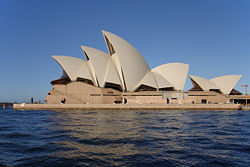 |
|
| Building | |
|---|---|
| Type | Arts complex |
| Architectural style | Expressionist |
| Structural system | Concrete frame & precast concrete ribbed roof |
| Location | Sydney, Australia |
| Construction | |
| Completed | 1973 |
| Design team | |
| Architect | Jørn Utzon |
| Structural engineer | Ove Arup & Partners |
The Sydney Opera House is located in Sydney, New South Wales, Australia. It was conceived and largely built by Danish architect Jørn Utzon, who in 2003 received the Pritzker Prize, architecture's highest honor.[1] The citation stated
| “ | There is no doubt that the Sydney Opera House is his masterpiece. It is one of the great iconic buildings of the 20th century, an image of great beauty that has become known throughout the world – a symbol for not only a city, but a whole country and continent. | ” |
The Opera House was made a UNESCO World Heritage Site on 28 June 2007.[2] It is one of the world's most distinctive 20th century buildings, and one of the most famous performing arts venues in the world.
World-renowned architect Louis Kahn has remarked: "The sun did not know how beautiful its light was until it was reflected off this building".
The Sydney Opera House is situated on Bennelong Point in Sydney Harbour, close to the Sydney Harbour Bridge. As well as many touring theatre, ballet, and musical productions, the Opera House is the home of Opera Australia, the Sydney Theatre Company and the Sydney Symphony. It is administered by the Sydney Opera House Trust, under the New South Wales Ministry of the Arts.
Contents |
Description
| Sydney Opera House* | |
|---|---|
| UNESCO World Heritage Site | |
|
|
|
| State Party | |
| Type | Cultural |
| Criteria | i |
| Reference | 166 |
| Region** | Asia-Pacific |
| Inscription history | |
| Inscription | 2007 (31st Session) |
| * Name as inscribed on World Heritage List. ** Region as classified by UNESCO. |
|
The Sydney Opera House is an expressionist modern design, with a series of large precast concrete 'shells'[3], each taken from a hemisphere of the same radius, forming the roofs of the structure. The Opera House covers 1.8 hectares (4.5 acres) of land. It is 183 metres (605 ft) long and about 120 metres (388 ft) wide at its widest point. It is supported on 588 concrete piers sunk up to 25 metres below sea level. Its power supply is equivalent for a town of 25,000 people. The power is distributed by 645 kilometres of electrical cable.
The roofs of the House are covered in a subtle chevron pattern with 1,056,006 glossy white and matte cream Swedish-made tiles [4], though from a distance the tiles look only white. Despite their self-cleaning nature, they are still subject to periodic maintenance and replacement.
The Concert Hall is contained within the western group of shells, the Opera Theatre within the eastern group. The scale of the shells is chosen to reflect the internal height requirements, rising from the low entrance spaces, over the seating areas and up to the high stage towers. The minor venues (Drama Theatre, Playhouse, and The Studio) are located beneath the Concert Hall, as part of the western shell group. A much smaller group of shells set to one side of the Monumental Steps houses the Bennelong Restaurant. Although the roof structures of the Sydney Opera House are commonly referred to as shells (as they are in this article), they are in fact not shells in a strictly structural sense, but are instead precast concrete panels supported by precast concrete ribs. [5]
Apart from the tile of the shells, and the glass curtain walls of the foyer spaces, the building's exterior is largely clad with aggregate panels composed of pink granite quarried in Tarana. Significant interior surface treatments also include off-form concrete, australian white birch plywood supplied from Wauchope in northern New South Wales, and brush box glulam.[6]
Performance venues and facilities
The Sydney Opera House contains five main performance spaces, other areas used for performances, a recording studio, five restaurants, and four souvenir shops.
The five venues making up the main performance facilities:
- The Concert Hall, with 2,679 seats, is the home of the Sydney Symphony, and used by a large number of other concert presenters. It contains the Sydney Opera House Grand Organ, the largest mechanical tracker action organ in the world, with over 10,000 pipes.
- The Opera Theatre, a proscenium theatre with 1,507 seats, is the Sydney home of Opera Australia and The Australian Ballet.
- The Drama Theatre, a proscenium theatre with 544 seats, is used by the Sydney Theatre Company and other dance and theatrical presenters.
- The Playhouse, an end-stage theatre with 398 seats.
- The Studio, a flexible space, with a maximum capacity of 400 people, depending on configuration.
Other spaces used for performances and other events include:
- The Utzon Room , a small multi-purpose venue, seating up to 210. It is the only interior space to have been designed by Utzon, having been renovated in 2004 under his direction.
- The Forecourt, a flexible open-air venue with a wide range of configuration options, including utilising the Monumental Steps as audience seating, used for a range of community events, Live Sites, and special-occasion performances.
Besides theatrical productions and concerts, venues at the Sydney Opera House are also used for activities such as conferences, ceremonies, and social functions.
Construction history
Origins
Planning for the Sydney Opera House began in the late 1940s when Eugene Goossens, the Director of the NSW State Conservatorium of Music, lobbied for a suitable venue for large theatrical productions. The normal venue for such productions, the Sydney Town Hall, was not considered large enough. By 1954, Goossens succeeded in gaining the support of NSW Premier Joseph Cahill, who called for designs for a dedicated opera house. It was also Goossens who insisted that Bennelong Point be the site for the Opera House. Cahill had wanted it to be on or near Wynyard Railway Station in the north-west of the CBD.[7]
The competition was launched by Cahill on 13 September 1955 and received a total of 233 entries from 32 countries. The criteria specified a large hall seating 3000 and a small hall for 1200 people, each to be designed for different uses including full-scale operas, orchestral and choral concerts, mass meetings, lectures, ballet performances and other presentations.[8] The winner, announced in 1957, was Jørn Utzon, a Danish architect. The prize was £5,000[9]. Utzon visited in Sydney in 1957 to help supervise the project[10]. His office moved to Sydney in February 1963.
Design and construction of the Opera House
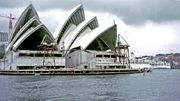
The Fort Macquarie Tram Depot, occupying the site at the time of these plans, was demolished in 1958, and formal construction of the Opera House began in March, 1959. The project was built in three stages. Stage I (1959–1963) consisted of building the upper podium. Stage II (1963–1967) saw the construction of the outer shells. Stage III consisted of the interior design and construction (1967–73).
Stage I: Podium
Stage I commenced on 5 December 1958, by the construction firm Civil & Civic, monitored by the engineers, Ove Arup and Partners. The government had pushed for work to begin early fearing that funding, or public opinion, might turn against them. However Utzon had still not completed the final designs. Major structural issues still remained unresolved (most notably the sails, which were still parabolic at the time). By 23 January 1961, work was running 47 weeks behind, mainly because of unexpected difficulties (inclement weather, unexpected difficulty diverting stormwater, construction beginning before proper construction drawings had been prepared, changes of original contract documents). Work on the podium was finally completed on 31 August 1962. The forced early start led to significant later problems, not least of which was the fact that the podium columns were not strong enough to support the roof structure, and had to be re-built.[11]
Stage II: Roof
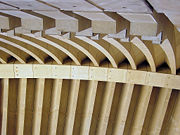
The shells of the competition entry were originally of undefined geometry,[12] but early in the design process the "shells" were perceived as a series of parabolas supported by precast concrete ribs. However, engineers, Ove Arup, were unable to find an acceptable solution to constructing them. The formwork for using in-situ concrete would have been prohibitively expensive, but because there was no repetition in any of the roof forms the construction of precast concrete for each individual section would possibly be even more expensive.
From 1957 to 1963 the design team went through at least twelve iterations of the form of the shells trying to find an economically acceptable form (including schemes with parabolas, circular ribs and ellipsoids) before a workable solution was completed. The design work on the shells involved one of the earliest uses of computers in structural analysis in order to understand the complex forces the shells would be subject to.[13] In mid-1961 Utzon himself found finally a solution to the problem: the shells all being created as sections from a sphere. Ove Arup's letter to Ashworth, a member of the Sydney Opera House Executive Committee, states: "Utzon came up with an idea of making all the shells of uniform curvature throughout in both directions."[13]
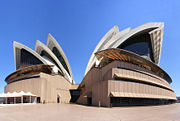
The shells were constructed by Hornibrook Group Pty Ltd[14], who were also responsible for construction in Stage III. Hornibrook manufactured the 2400 precast ribs and 4000 roof panels in an on-site factory, and also developed the construction processes.[11] The achievement of this solution avoided the need for expensive formwork construction by allowing the use of precast units (it also allowed the roof tiles to be prefabricated in sheets on the ground, instead of being stuck on individually at height). Ove Arup and Partners' site engineer supervised the construction of the shells which used an innovative adjustable steel trussed 'erection arch' to support the different roofs before completion. On 6 April 1962 it was estimated that the Opera House would be completed between August 1964 and March 1965. By the end of 1965, the estimated finish for stage II was July 1967.
Stage III: Interiors
Stage III, the interiors, started with Utzon moving his entire office to Sydney in February 1963. However, there was a change of government in 1965, and the new Robert Askin government declared the project under the jurisdiction of the Ministry of Public Works. This ultimately led to Utzon's resignation in 1966 (see below).
The cost of the project so far, even in October of 1966, was still only $22.9 million, less than a quarter of the final $102 million cost.
The second stage of construction was progressing toward completion when Utzon resigned. His position was principally taken over by Peter Hall, who became largely responsible for the interior design. Other persons appointed that same year to replace Utzon were E. H. Farmer as government architect, D. S. Littlemore and Lionel Todd.
Following Utzon's resignation, the acoustic advisor, Lothar Cremer, confirmed to SOHEC that Utzon's original acoustic design only allowed for 2000 seats in the main hall, and further stated that increasing the number of seats to 3000 would be disastrous for the acoustics.
The four significant changes to the design after Utzon left were:
- The cladding to the podium and the paving (the podium was originally not to be clad down to the water, but to be left open).
- The construction of the glass walls (Utzon was planning to use a system of prefabricated plywood mullions, but a different system was designed to deal with the glass).
- Use of the halls: The major hall which was originally to be a multipurpose opera/concert hall, became solely a concert hall, called the Concert Hall. The minor hall, originally for stage productions only, had the added function of opera and ballet to deal with and is called the Opera Theatre. As a result, the "Opera Theatre" is inadequate to stage large scale opera and ballet. A theatre, a cinema and a library were also added, (later changed to two live drama theatres and a studio). The layout of the interiors was changed and the stage machinery, already designed and fitted inside the major hall, was pulled out and largely thrown away.
- The interior designs: Utzon's exquisite plywood corridor designs, and his acoustic and seating designs for the interior of both major halls, were scrapped completely. His design for the Concert Hall was rejected as it only seated 2000, which the Askin government decided was insufficient.[13] The subsequent Todd, Hall and Littlemore versions of both major halls have notorious problems with acoustics. The orchestra pit in the Opera Theatre is cramped and dangerous to musicians' hearing.[15] The Concert Hall has a very high roof leading to lack of early reflections onstage — perspex rings (the "acoustic clouds") hanging over the stage were added shortly before opening in an (unsuccessful) attempt to address this problem. (Significantly, Utzon later employed the acoustic consultant Lothar Cremer, who modeled his designs for the major halls and found them to be perfect.)
The Opera House was formally completed in 1973, having cost $102 million[16]. H.R. ‘Sam’ Hoare, the Hornibrook director in charge of the project, provided the following approximations in 1973: Stage I: podium Civil & Civic Pty Ltd approximately $5.5m. Stage II: roof shells M.R. Hornibrook (NSW) Pty Ltd approximately $12.5m. Stage III: completion The Hornibrook Group $56.5m. Separate contracts: stage equipment, stage lighting and organ $9.0m. Fees and other costs $16.5m.
The original cost estimate in 1957 was £3,500,000 ($7 million). The original completion date set by the government was 26 January 1963 (Australia Day).[13]

Utzon and his resignation
Frank Gehry – architect and Pritzker Prize jury member 2003
| “ | Utzon made a building well ahead of its time, far ahead of available technology, and he persevered through extraordinary malicious publicity and negative criticism to build a building that changed the image of an entire country. | ” |
Before the Sydney Opera House competition, Utzon had won seven of the eighteen competitions he had entered, but had never seen any of his designs built.[13] Utzon's submitted concept for the Sydney Opera House was almost universally admired and considered groundbreaking. The Assessors Report of January 1957, stated:
| “ | The drawings submitted for this scheme are simple to the point of being diagrammatic. Nevertheless, as we have returned again and again to the study of these drawings, we are convinced that they present a concept of an Opera House which is capable of becoming one of the great buildings of the world. | ” |
For the first stage of the project Utzon worked very successfully with the rest of the design team and the client, but as the project progressed the Cahill government insisted on progressive revisions. They also did not fully appreciate the costs or work involved in design and construction. Tensions between the client and the design team grew further when an early start to construction was demanded despite an incomplete design. This resulted in a continuing series of delays and setbacks while various technical engineering issues were being refined. The building was unique, and the problems with the design issues, and costs increases, were exacerbated by commencement of work before the completion of the final plans.
After the election of the Askin government in 1965 the relationship of client, architect, engineers and contractors became increasingly tense. Askin had been a 'vocal critic of the project prior to gaining office.'[17] His new Minister for Public Works, Davis Hughes, was even less sympathetic. Elizabeth Farrelly, Australian architecture critic has written that
| “ | at an election night dinner party in Mosman, Hughes's daughter Sue Burgoyne boasted that her father would soon sack Utzon. Hughes had no interest in art, architecture or aesthetics. A fraud, as well as a philistine, he had been exposed before Parliament and dumped as Country Party leader for 19 years of falsely claiming a university degree. The Opera House gave Hughes a second chance. For him, as for Utzon, it was all about control; about the triumph of homegrown mediocrity over foreign genius.[18] | ” |
Differences ensued. One of the first was that Utzon believed the clients should receive information on all aspects of the design and construction through his practice, while the clients wanted a system (notably drawn in sketch form by Davis Hughes, where architect, contractors, and engineers each reported to the client directly, and separately. This had great implications for procurement methods and cost control, with Utzon wishing to negotiate contracts with chosen suppliers (such as Ralph Symonds for the plywood interiors), and the New South Wales government insisting contracts were put out to tender.[11]
Utzon was highly reluctant to respond to questions or criticism from the client's "Sydney Opera House Executive Committee" (SOHEC).[13] However he was greatly supported throughout by a member of the committee and one of the original competition judges, Professor Harry Ingham Ashworth. Utzon was unwilling to compromise on some aspects of his designs that the clients wanted to change.
Utzon's ability was never in doubt, despite questions raised by Davis Hughes, who attempted to portray Utzon as an impractical dreamer. Ove Arup actually stated that Utzon was "probably the best of any I have come across in my long experience of working with architects"[13], and:
| “ | The Opera House could become the world's foremost contemporary masterpiece if Utzon is given his head. | ” |
In October 1965, Utzon gave Hughes a schedule setting out the completion dates of parts of his work for stage III. Utzon was at this time working closely with Ralph Symonds, a manufacturer of plywood based in Sydney and highly regarded by many, despite an Arup's engineer warning that Ralph Symonds' "knowledge of the design stresses of plywood, was extremely sketchy" and that the technical advice was "elementary to say the least and completely useless for our purposes". Australian architecture critic, Elizabeth Farrelly, has referred to Ove Arup's project engineer Michael Lewis as having "other agendas"[19]. In any case, Hughes shortly after withheld permission for the construction of plywood prototypes for the interiors, and the relationship between Utzon and the client never recovered. By February 1966 Utzon was owed more than $100,000 in fees[20]. Hughes then withheld funding so that Utzon couldn't even pay his own staff. The government minutes record that following several threats of resignation, Utzon finally stated to Davis Hughes: "If you don't do it, I resign". Hughes replied: "I accept your resignation. Thank you very much. Goodbye."[13]
Utzon left the project on 28 February 1966. He said that Hughes' refusal to pay Utzon any fees and the lack of collaboration caused his resignation, and later famously described the situation as "Malice in Blunderland". In March 1966, Hughes offered him a subordinate role as 'design architect' under a panel of executive architects, without any supervisory powers over the House's construction, but Utzon rejected this.
Following the resignation, there was great controversy about who was in the right and who was in the wrong. The Sydney Morning Herald initially reported: "No architect in the world has enjoyed greater freedom than Mr Utzon. Few clients have been more patient or more generous than the people and the Government of NSW. One would not like history to record that this partnership was brought to an end by a fit of temper on the one side or by a fit of meanness on the other." And on 17 March 1966 it reported:[13] "It was not his fault that a succession of Governments and the Opera House Trust should so signally have failed to impose any control or order on the project .... his concept was so daring that he himself could solve its problems only step by step .... his insistence on perfection led him to alter his design as he went along."
Yet in an article in Harvard Design Magazine in 2005 [21], professor Bent Flyvbjerg notes that Utzon fell victim to a politically lowballed construction budget, which eventually resulted in a cost overrun of 1,400 percent. The overrun and the ensuing scandal that it created kept Utzon from building more masterpieces. This, according to Flyvbjerg, is the real cost of the Sydney Opera House:
| “ | Utzon was thirty-eight when he won the competition for the Opera House - how would the work of the mature master have enriched our lives? We'll never know. That's the high price Sydney has imposed by its incompetence in building the Opera House. | ” |
The Sydney Opera House opened the way for the immensely complex geometries of some modern architecture. The design was one of the first examples of the use of computer analysis to design complex shapes. The design techniques developed by Utzon and Arup for the Sydney Opera House have been further developed and are now used for architecture such as works of Gehry and "blobitecture", as well as most reinforced concrete structures. The design is also one of the first in the world to use araldite to glue the precast structural elements together, and proved the concept for future use.
The Opera House was also a first in mechanical engineering. Another Danish firm, Steensen Varming, was responsible for designing the new air conditioning plant, the largest in Australia at the time, supplying over 600,000 cubic feet (17,000 m3) of air per minute [22], using the innovative idea of harnessing the harbour water to create a water cooled heat pump system that is still in operation today [23]
Opening
The Opera House was formally opened by Elizabeth II, Queen of Australia, on 20 October 1973, which a crowd of millions attended. The architect was not invited to the ceremony, nor was his name mentioned. The opening was televised and included fireworks and a performance of Beethoven's Symphony No. 9.
Prior to the opening, two performances had already taken place in the finished building. On 28 September, a performance of Sergei Prokofiev's opera War and Peace was presented in the Opera Theatre. On 29 September, the first public concert in the Concert Hall took place. It was an all-Wagner concert, performed by the Sydney Symphony, conducted by Charles Mackerras and with accompanying singer Birgit Nilsson. The first lieder recital was also given by Birgit Nilsson, accompanied by Geoffrey Parsons, on 6 October.[24] The first violin and piano recital was given by Wanda Wiłkomirska, also with Geoffrey Parsons.[25]
During the construction of the Opera House, a number of lunchtime performances were arranged for the workers, with Paul Robeson the first artist to perform at the (unfinished) Opera House in 1960.
Reconciliation with Utzon and new works
Beginning in the late 1990s, the Sydney Opera House Trust began to communicate with Jørn Utzon in an attempt to effect a reconciliation, and to secure his involvement in future changes to the building. In 1999 he was appointed by the Trust as a design consultant for future work.[26] In 2004, the first interior space rebuilt to match Utzon's original design was opened, and renamed "The Utzon Room" in his honour.[27] In April 2007, he proposed a major reconstruction of the Opera Theatre.[28] Utzon died on 29 November 2008.[29]
In 1993 Constantine Koukias was commissioned by the Sydney Opera House Trust in association with REM Theatre to compose Icon, a large-scale music theatre piece for the 20th anniversary of the Sydney Opera House.
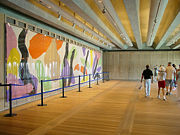
Anti-war protest
On 18 March 2003, Dr Will Saunders, a Briton, and David Burgess, an Australian, scaled one of the sails of the Opera house and painted the words 'NO WAR' in prominent red letters as an expression of their objection to the then-proposed involvement of Australian troops in the conflict in Iraq. The painted message was removed by maintenance workers on the following day. Security services for the Opera House were subsequently upgraded to prevent further unauthorised access.[30]
See also
- List of official openings by Elizabeth II in Australia
- Wonders of the World
- Interview with Utzon, October 1992
References
- ↑ Sydney Morning Herald - his death
- ↑ Braithwaite, David (2007-06-28). "Opera House wins top status", The Sydney Morning Herald. Retrieved on 2007-06-28.
- ↑ Shells of the Sydney Opera House, The Royal Society of New South Wales
- ↑ "Företagsbroschyr". CCHöganäs. CCHöganäs. Retrieved on 2008-03-10.
- ↑ "Sydney Opera House". Tom Fletcher. Retrieved on 2008-02-10.
- ↑ Littlemore, D.S.. Sydney Opera House, Anatomy of Stage Three construction and completion: a general index. Public Works Department, NSW.
- ↑ http://www.sydneyarchitecture.com/ROC/QUA01.htm
- ↑ Ziegler, Oswald (1973). Sydney Builds an Opera House. Oswald Ziegler Publications. pp. 35.
- ↑ Eric Ellis interview with Utzon in the Sydney Morning Herald Good Weekend, 31 October, 1992, http://www.ericellis.com/utzon.htm Retrieved 2 December, 2008
- ↑ "Millennium Masterwork: Jorn Utzon's Sydney Opera House". Hugh Pearman. Gabion. Retrieved on 2007-06-28.
- ↑ 11.0 11.1 11.2 Murray, Peter (2004). The Saga of the Sydney Opera House. London: Spon Press. ISBN 0415325218.
- ↑ Arup, Ove and Zunz, G.J.: Article in Structural Engineer Volume 47, March 1969
- ↑ 13.0 13.1 13.2 13.3 13.4 13.5 13.6 13.7 13.8 Jones, Peter: Ove Arup: Masterbuilder of the Twentieth Century. Yale University Press, 2006.
- ↑ Bilfinger Berger corporate history
- ↑ Sydney Morning Herald (Joyce Morgan) (November 2006). "The phantoms that threaten the opera house". Retrieved on 2007-03-13.
- ↑ New South Wales Government, Department of Commerce, http://www.records.nsw.gov.au/archives/archives_in_brief_28_1492.asp Accessed 1 December, 2008
- ↑ Farrelly, Elizabeth, 'High noon at Bennelong Point' in Canberra Times, http://www.canberratimes.com.au/news/national/national/general/high-noon-at-bennelong-point/1374056.aspx?storypage=0, Accessed 1 December, 2008
- ↑ Farrelly, Elizabeth, 'High noon at Bennelong Point' in Canberra Times, http://www.canberratimes.com.au/news/national/national/general/high-noon-at-bennelong-point/1374056.aspx?storypage=0, Accessed 1 December, 2008
- ↑ Farrelly, Elizabeth, 'High noon at Bennelong Point' in Canberra Times, http://www.canberratimes.com.au/news/national/national/general/high-noon-at-bennelong-point/1374056.aspx?storypage=0, Accessed 1 December, 2008
- ↑ http://www.canberratimes.com.au/news/national/national/general/high-noon-at-bennelong-point/1374056.aspx?storypage=0
- ↑ http://flyvbjerg.plan.aau.dk/HARVARDDESIGN63PRINT.pdf
- ↑ Sunday Mail, 9 April 1972
- ↑ A. Building a masterpiece 2006
- ↑ Wagner Society in NSW Inc: Birgit Nilsson
- ↑ Interview with Wanda Wilkomirska
- ↑ Sydney Opera House Media Release (August 1999). "Utzon Appointment: 'Reunites The Man and his Masterpiece'". Retrieved on 2007-03-13.
- ↑ chiefengineer.org. "The Sydney Opera House". Retrieved on 2007-03-13.
- ↑ Benns, Matthew (2007-04-08). "Utzon wants to tear up floor of the Opera House", The Sydney Morning Herald. Retrieved on 2007-04-12.
- ↑ "Sydney Opera House designer Joern Utzon dies", Associated Press (2008-11-30). Retrieved on 2008-11-30.
- ↑ Maley, Jacqueline (2003-03-19). "24–7 guard for Opera House", The Sydney Morning Herald. Retrieved on 2008-10-03.
Further reading
- Hubble, Ava, The Strange Case of Eugene Goossens and Other Tales from The Opera House, Collins Publishers, Australia, 1988. (Ava Hubble was Press Officer for the SOH for fifteen years).
- Duek-Cohen, Elias, Utzon and the Sydney Opera House, Morgan Publications, Sydney, 1967–1998. (A small publication originally intended to gather public opinion to bring Utzon back to the project).
- Stuber, Fritz, Sydney's Opera House — Not a World Heritage Item? — Open letter to the Hon. John W. Howard, Prime Minister, in: Australian Planner (Sydney), Vol. 35, No. 3, 1998 (p. 116); Architecture + Design (New Delhi), Vol. XV, No. 5, 1998 (pp. 12–14); collage (Berne), No. 3, 1998, (pp. 33–34, 1 ill.).
- "Opera House an architectural 'tragedy"', ABC News Online, 28 April 2005.
- Flyvbjerg, Bent, "Design by Deception: The Politics of Megaproject Approval", Harvard Design Magazine, Volume 22, 2005.
- Watson, Anne (editor): "Building a Masterpiece: The Sydney Opera House", 2006, Lund Humphries, ISBN-10: 0853319413, ISBN-13: 978-0853319412
External links
- Official website
- Architect-led tours of Sydney Opera House
- World heritage listing for Sydney Opera House
- Photographs of the construction
- Wolanski Foundation's annotated list of sources on Sydney Opera House
|
|||||||
|
|||||||||||||||||||||||